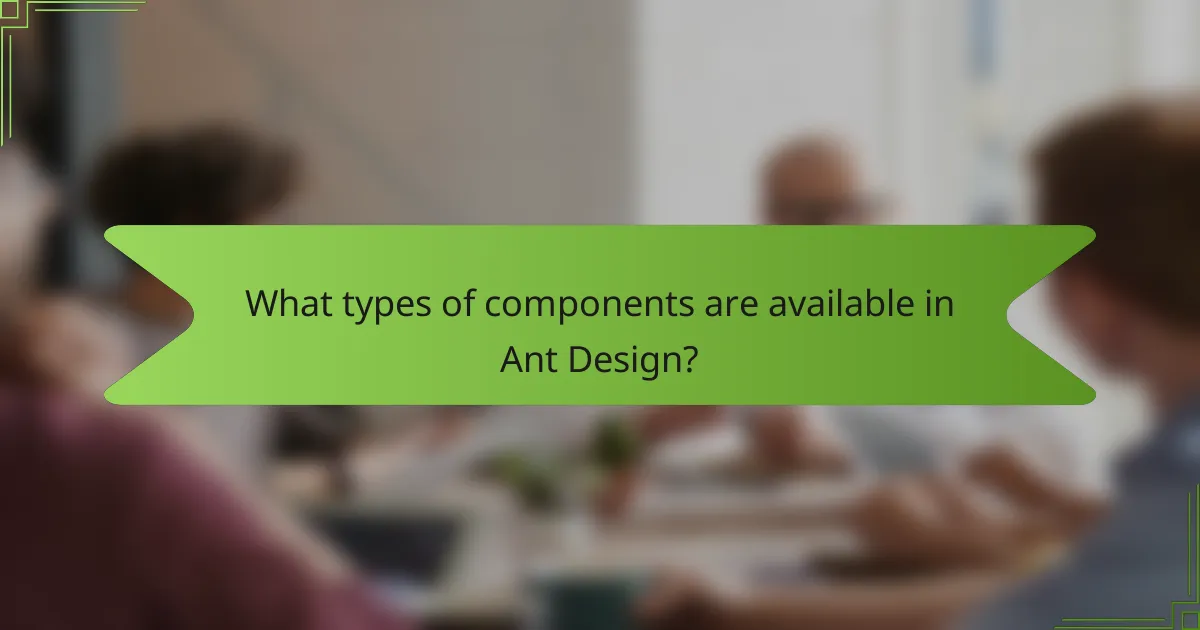Ant Design is a comprehensive design system that emphasizes user-centric principles to enhance the usability and aesthetic appeal of applications. It comprises core principles such as design philosophy, design language, and design guidelines, which collectively promote consistency and clarity in user interfaces. The system offers a diverse range of components, including basic elements, advanced components, and specialized tools for navigation and data visualization. Additionally, Ant Design features customizable theming capabilities that allow developers to adjust styles and support both light and dark modes, ensuring a flexible and tailored user experience.

What are the core principles of Ant Design?
The core principles of Ant Design include design philosophy, design language, and design guidelines. The design philosophy emphasizes a user-centric approach. It aims to create an efficient and enjoyable user experience. The design language focuses on consistency and clarity in visual communication. This ensures that users can navigate interfaces intuitively. The design guidelines provide a comprehensive framework for developers. They cover components, layouts, and interactions. These principles collectively enhance usability and aesthetic appeal in applications. Ant Design’s principles are grounded in real-world usage and feedback from developers and users.
How do these principles influence design decisions?
The principles of Ant Design significantly influence design decisions by providing a structured framework for user interface design. These principles emphasize consistency, clarity, and usability. They guide designers in creating intuitive and aesthetically pleasing interfaces. For instance, the principle of consistency ensures that elements behave similarly across the application. This reduces the learning curve for users. Clarity focuses on making information easily understandable, which enhances user experience. Usability principles prioritize user needs, leading to more effective interactions. Overall, these principles help streamline the design process and improve the end product’s quality.
What are the key attributes of Ant Design’s principles?
The key attributes of Ant Design’s principles include clarity, consistency, and adaptability. Clarity ensures that design elements are easy to understand and interact with. Consistency maintains a uniform look and feel across different components. Adaptability allows the design to be flexible for various applications and user needs. These attributes support user experience and enhance usability. Ant Design’s principles are grounded in these attributes to create effective and efficient interfaces.
Why are these principles important for user experience?
These principles are important for user experience because they guide the design process towards creating intuitive and efficient interfaces. Effective principles enhance usability, ensuring users can navigate and interact with products easily. They promote consistency across components, which helps users build familiarity with the interface. Research shows that consistent design can improve user satisfaction by up to 80%. Furthermore, these principles support accessibility, making products usable for a wider audience. By prioritizing user needs, the principles ultimately lead to higher engagement and retention rates.
What role does consistency play in Ant Design?
Consistency is crucial in Ant Design as it ensures a cohesive user experience. It provides a unified visual language across components. This uniformity aids users in navigating applications intuitively. Ant Design follows a systematic design philosophy, which enhances usability. The design system includes standardized components and styles. These elements are consistently applied throughout the framework. This approach minimizes confusion and learning curves for users. Research shows that consistent design increases user satisfaction and productivity.
How does Ant Design maintain visual consistency across components?
Ant Design maintains visual consistency across components by implementing a design language based on a cohesive set of guidelines. These guidelines include standardized spacing, color palettes, and typography. Each component adheres to these specifications, ensuring uniformity in appearance and behavior. The design system also utilizes a grid layout to align elements consistently. Additionally, Ant Design provides a comprehensive style guide that outlines the usage of components. This approach promotes a seamless user experience across different platforms and devices. The consistent application of these principles results in a harmonious interface that enhances usability and accessibility.
What are the implications of consistency for developers?
Consistency in design implies that developers create a unified user experience across applications. This uniformity enhances usability and reduces confusion for users. It allows developers to build components that are predictable in behavior and appearance. Consistency also streamlines the development process, as developers can reuse components across projects. This leads to faster development times and fewer errors. Furthermore, it fosters a cohesive brand identity, as users associate consistent designs with professionalism. Research shows that consistent interfaces can improve user satisfaction by 20% (Nielsen Norman Group). Therefore, maintaining consistency is crucial for effective development and user engagement.

What types of components are available in Ant Design?
Ant Design offers a variety of components designed for building user interfaces. These components include basic elements such as buttons, icons, and typography. Advanced components like tables, forms, and modals are also available. Additionally, Ant Design provides layout components, such as grids and cards. Navigation components, including menus and breadcrumbs, enhance user experience. Feedback components like alerts and notifications help users understand system status. Data visualization components, such as charts and graphs, present information effectively. Finally, Ant Design includes specialized components like date pickers and sliders for specific functionalities.
How are components categorized in Ant Design?
Ant Design components are categorized into several groups based on their functionality and purpose. The main categories include General, Layout, Navigation, Data Entry, Data Display, Feedback, and Others. Each category serves specific design needs and user interactions. For example, General components include buttons and icons, while Layout components cover grids and layouts. Navigation components help users move through the interface, and Data Entry components facilitate user input. Data Display components present information, while Feedback components provide user notifications. This categorization helps developers easily find and implement the appropriate components for their applications.
What are the primary categories of components?
The primary categories of components in Ant Design are basic components, layout components, navigation components, data entry components, and data display components. Basic components include buttons, icons, and typography. Layout components consist of grid, layout, and space. Navigation components encompass menus, tabs, and pagination. Data entry components feature forms, inputs, and sliders. Data display components include tables, lists, and cards. Each category serves distinct functions within the design framework, ensuring versatility in user interface development.
Which components are most commonly used in applications?
The most commonly used components in applications include buttons, input fields, and modals. Buttons facilitate user interactions and are essential for actions like submitting forms. Input fields allow users to enter data, making them crucial for forms and search functions. Modals provide a way to display information or prompts without navigating away from the current page. Other frequently utilized components are tables for data display, dropdowns for selection options, and notifications for user alerts. These components are integral to user experience and interface design in applications.
What are the unique attributes of specific Ant Design components?
Ant Design components possess unique attributes that enhance user experience and functionality. For example, the Button component features a loading state, allowing users to indicate ongoing processes. The Input component includes an affix option for adding icons or text to the input field. The Table component supports customizable columns, enabling users to define which data to display. The Modal component offers a confirm functionality for user actions, enhancing interaction clarity. The DatePicker component allows for date range selection, providing flexibility in date input. The Card component supports multiple content types, such as images and text, allowing for versatile displays. Each of these attributes is designed to improve usability and interface consistency across applications.
How does the Button component differ from other components?
The Button component differs from other components by serving as a primary interactive element in user interfaces. It is designed to trigger actions such as submitting forms or initiating processes. Unlike static components, the Button component has distinct states like hover, active, and disabled. This interactivity is essential for enhancing user engagement. Additionally, Button components often come with customizable attributes such as size, type, and shape. These attributes allow for flexibility in design and functionality. The Button’s role is critical in guiding user behavior within applications, making it a unique entity among components.
What functionality do Form components provide in Ant Design?
Form components in Ant Design provide a structured way to collect and validate user input. They enable form data management through controlled components. Ant Design’s Form components support various input types, including text fields, checkboxes, and radio buttons. They also facilitate validation rules, allowing developers to enforce input criteria. The components include features for layout control, such as horizontal or vertical alignment. Additionally, they offer built-in error handling and display messages for user guidance. This functionality enhances user experience and ensures data integrity during form submission.

How does theming work in Ant Design?
Theming in Ant Design allows developers to customize the appearance of components. It uses a set of design tokens to define colors, fonts, and other styles. Developers can override default variables in the Ant Design theme configuration. This customization can be done globally or for specific components. Theming supports both light and dark modes. It also enables dynamic theming, allowing changes at runtime. Ant Design provides a theme tool for visual adjustments. This tool simplifies the theming process by generating CSS styles based on user preferences.
What are the benefits of theming in Ant Design?
The benefits of theming in Ant Design include customization, consistency, and improved user experience. Customization allows developers to tailor the appearance of components to match brand identity. This flexibility supports various design requirements across different projects. Consistency is achieved through a unified design language, ensuring that all components adhere to the same visual style. This coherence enhances usability and reduces cognitive load for users. Improved user experience stems from the ability to create visually appealing interfaces that resonate with users. Theming also facilitates rapid development, as pre-defined themes can be applied easily across multiple components. Overall, theming in Ant Design streamlines the design process and fosters a more engaging interaction for users.
How can developers customize themes effectively?
Developers can customize themes effectively by utilizing Ant Design’s built-in theming capabilities. They can modify the default variables in the Less files to change colors, fonts, and spacing. This allows for a tailored visual experience that aligns with brand identity. Additionally, developers can implement custom themes using the theme configuration option in the Ant Design library. This option enables dynamic theme switching at runtime. According to the Ant Design documentation, developers can also leverage the ThemeProvider component for global theme management. This approach facilitates consistent styling across the application. By following these methods, developers can achieve an effective and cohesive theme customization.
What tools are available for theme customization?
Ant Design offers various tools for theme customization. Key tools include the Ant Design Theme Customization feature, which allows users to modify default styles using a configuration file. The Less preprocessor is utilized to adjust variables for colors, fonts, and other design elements. Additionally, the Ant Design Pro provides a more extensive set of customization options through its built-in theming capabilities. Users can also leverage CSS-in-JS solutions for dynamic styling adjustments. These tools enable developers to create unique themes while maintaining design consistency across applications.
What are the best practices for implementing themes in Ant Design?
Use a consistent naming convention for theme variables in Ant Design. This practice ensures clarity and maintainability. Utilize the built-in theming features provided by Ant Design. These features allow for easy customization of styles. Leverage Less variables to define your theme. This method is efficient for managing colors and spacing. Implement a design token system for scalability. Design tokens help maintain consistency across components. Test themes across different screen sizes and devices. This step ensures usability and accessibility. Document your theme changes thoroughly. Documentation aids team collaboration and future updates.
How can themes enhance the overall user experience?
Themes enhance the overall user experience by providing a cohesive visual identity. A consistent theme improves navigation and usability. It allows users to easily recognize and interact with interface elements. Customizable themes cater to user preferences, increasing satisfaction. Research indicates that visual consistency can reduce cognitive load by 30%. This leads to quicker task completion and improved user retention. Themes also support branding, reinforcing the organization’s identity. A well-designed theme can elevate user engagement and loyalty.
What common pitfalls should developers avoid when theming?
Developers should avoid several common pitfalls when theming. First, neglecting consistency across components can lead to a disjointed user experience. Each themed element should align with the overall design language. Second, failing to consider accessibility can alienate users with disabilities. Color contrasts and font sizes must meet accessibility standards. Third, overcomplicating the theme can make maintenance difficult. A simpler, modular approach is often more sustainable. Fourth, ignoring responsive design can result in poor performance on various devices. Themes should adapt seamlessly to different screen sizes. Lastly, not testing the theme in real scenarios can overlook usability issues. Conducting user testing ensures the theme meets user needs effectively.
What practical tips can enhance the use of Ant Design?
To enhance the use of Ant Design, developers should utilize its comprehensive documentation effectively. This documentation provides clear guidelines and examples for each component. Leveraging the built-in design tokens can ensure consistent styling across applications. Customizing themes through the provided theming capabilities can improve brand alignment. Implementing responsive design principles is essential for mobile compatibility. Utilizing Ant Design’s form validation features enhances user input reliability. Regularly updating to the latest version ensures access to new features and bug fixes. Engaging with the Ant Design community can provide valuable insights and support.
Ant Design is a comprehensive design framework that emphasizes user-centric principles, offering a structured approach to user interface design. The article explores its core principles, including design philosophy, language, and guidelines that enhance usability and aesthetic appeal. It details the variety of components available, categorized by functionality, and highlights the importance of consistency in design for improved user experience. Additionally, the article covers theming capabilities, customization options, and best practices for implementing themes to align with brand identity while ensuring accessibility and usability.


